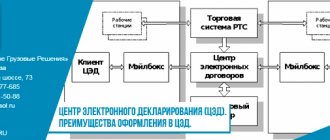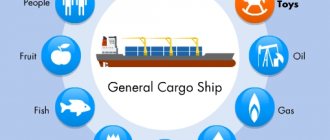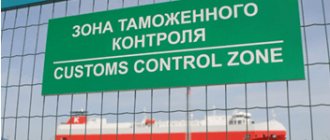The burden on customs authorities increases in proportion to the growth of international trade. This situation was predictable, so the gradual introduction of electronic document management into the work of customs began. The creation of the EAEU further influenced the development of information technologies when moving goods across borders. The introduction of an electronic customs declaration has significantly facilitated the interaction between the border supervisory authority and foreign trade participants.
OBJECTIVES OF CUSTOMS DECLARATION:
- Provide customs authorities with data on the types and quantities of imported and exported products, as well as transport;
- Show the legality of transactions performed by the declarant with cargo and transport that fall under a certain customs regime;
- Monitor compliance of information about goods and transport in documents with the actual information.
The procedure for customs declaration in the Russian Federation is regulated by orders of the Federal Customs Service of Russia, the main one being Order of the Federal Customs Service of Russia No. 1761 dated September 17, 2013. The procedure for customs declaration in the EU is determined by the EU Customs Code. When moving goods within the EAEU, customs declaration is not applied on the basis of Article 25 of the Treaty on the EAEU dated May 29, 2014, except for the cases specified in the Treaty.
To carry out customs declaration on the territory of the Russian Federation, a customs declaration is submitted to the customs office by the declarant himself or a customs representative on behalf of the declarant, which represents complete information on the goods being transported, the customs procedure, type of transportation and customs duties.
There are several types of customs declarations: declaration for goods, transit declaration, passenger customs declaration, declaration for a vehicle.
- Declaration of Goods (DT) is a reporting form that is required in the case of transporting goods across the border between countries. The DT specifies information about the product, its cost, terms of delivery, places of collection and delivery of the goods.
- Transit declaration (T1) is a document that is submitted to customs when the goods pass through the EU countries under the customs transit procedure. Form T1 contains data on the goods and vehicles that transport them.
- Passenger customs declaration is a special reporting form for individuals who transport personal goods across the customs border.
- Vehicle declaration is a reporting form required when importing or exporting a vehicle into or out of the country. The document contains detailed information about the vehicle: make, model, VIN number, type of vehicle according to the vehicle classifier, country of registration, etc.
Procedure for electronic declaration of goods
Customs declaration in electronic form is carried out by the declarant independently or through a customs representative. In both cases, the procedure for submitting an ED will consist of the following steps:
- All necessary documents are prepared, including their translation into XML format (declaration of goods, declaration of customs value and list of documents presented).
- The prepared materials are sent to the electronic archive of the declarant.
- The program initiates a customs clearance procedure, and the ED is transferred with a set of materials to customs. If, at the beginning of the customs clearance procedure, “Remote release” is selected, then changing it to “Regular” will no longer be possible, since its opening occurs automatically based on the analysis of the data specified in column 30 of the ED and the place of filing the declaration. The transfer of ED and documents to it is carried out automatically by the program after the successful opening of the customs clearance procedure.
- A customs officer checks the declaration, based on the results of which the document is assigned a unique number in the system or the declarant is sent a notice of refusal to register it, indicating any errors made. After corrections are made to the ED, the documents attached to it are submitted again. A customs officer and a foreign trade participant have the opportunity to exchange electronic messages on issues related to filling out the electronic document.
- In some cases, customs inspection of goods will be required. The customs office notifies the declarant of the decision, who is obliged to confirm receipt of the message. Based on the results of the inspection, a report is drawn up. An electronic copy is sent to the foreign trade participant.
- After completing all formalities at customs and completing the verification of the electronic declaration for goods, customs assigns it the status “Release Authorized.” From this moment, the electronic declaration procedure is considered completed.
- After the release of the goods, adjustments can be made to the ED (if necessary).
In this procedure, the customs representative represents the interests of the participant in foreign trade activities and fills out all the necessary forms for him, and also promptly answers questions received from the inspector that arise in connection with the verification of the electronic document.
On a note:
The customs authority may request written documents to confirm the information specified in the electronic declaration if, during the inspection or inspection of the cargo, certain risks are identified or a discrepancy is established with the information specified in the ED.
COST OF CUSTOMS DECLARATION
The cost of the customs declaration service in our company is fixed and equals 15,000 rubles.* To order the service, fill out an application on our website, and a customs clearance specialist will contact you within an hour.
*The cost of the service may vary upward for the following reasons: the number of goods in the declaration, the complexity of the goods, the collection of evidence is required for the indicated low price of the goods. More details about the cost of customs representative services are described in the price list.
Electronic Declaration Center (EDC)
Advantages of customs clearance at CED
Today, customs clearance of goods can be carried out with the help of the CED - a special government body created with the help of modern technologies. Its purpose is to carry out customs clearance of goods located at any posts within the country, but subject to a specific regional customs office (depending on the choice of the CED itself). As a result, if you submit a declaration here, you can release the cargo at any post controlled by this authority. And there is no need to attend in person (or send a representative).
The main advantages of electronic declaration of goods
Such centers where electronic declaration is carried out have a number of undeniable advantages:
- Availability - no matter what region you are in. This is not a problem for a resident of a big city, where there is a standard customs post, but for people living “in the outback”, using the Internet is a real gift (no time or money spent on a trip to customs);
- Significant speed of processing such a declaration - in most cases, processing data and releasing goods takes up to 3 hours;
- Information content - all the necessary data regarding deliveries is stored on the servers for a long time. As a result, registration takes very little time due to quick access to the necessary information;
- There is no personal communication - all dialogues between the interested party and the inspector are carried out via the network. When working online, time does not matter much - you can contact us at any convenient time. However, it must be taken into account that the inspector may work in a different time zone;
- All declarations submitted in this way are endorsed by the digital signature of the company that imports goods into the country. As a result, it is possible to accurately identify the declarant, plus it is easy to establish the reliability of all entered information. And these features of customs clearance significantly simplify the process itself. Plus, with a signature, it becomes impossible to make changes to the document, as well as to gain unauthorized access to them;
- If there is a need for additional inspection of goods, it can be performed at the temporary storage warehouse where the cargo is located. Or at the terminal. To do this, the CED inspector simply issues an order to the border customs post (where the necessary cargo is stored) via the network. And also receives a response to the request;
- Significantly saves time on any customs operations for the release of goods. Transportation costs are also saved;
- You can obtain a paper copy of the customs declaration (the original of which is electronic) at any customs office included in the CED. Moreover, with all the necessary marks. And such a document has legal force, so it can easily be used in court if necessary.
However, it is worth noting several important difficulties in clearing cargo using CED:
- This type of design is new and has been practiced recently. As a result, data must be provided in a certain prescribed form, otherwise the system will not be able to process it. And you need to know this order very well, otherwise you can easily make mistakes;
- Not all customs posts are ready to cooperate with the CED authority. Of course, their number is gradually increasing every day, but not all of them accept this type of design. Therefore, you need to select suitable posts in advance.
By the way, the cost of customs clearance of goods will still depend on the type of cargo and type of clearance. As well as a number of additional services provided (if there is a need for them).
Documents required for customs clearance, declaration of goods in the Central Economic Office
It is worth noting that the easiest way to contact the EDC is for a legal entity. And for proper cargo clearance you will need:
- A document in Word format, which is a copy of the decision of the shareholders of the founding council on the creation of your company;
- A document in Word format, which is an electronic copy of the organization’s charter with the necessary signatures and seals;
- Certificate from the tax service confirming the registration of your company;
- An extract from the Unified State Register of Legal Entities, which must be new (only documents issued no later than 30 days ago are accepted);
- A copy of the state registration certificate;
- Notification of the State Statistics Committee;
- An extract from the bank servicing your company with the obligatory indication of OKPO. Its validity period also does not exceed 30 days from the date of receipt.
You can learn more about the required documents in consultation with a broker specialist.
Professional customs broker in Russia or why choose us
There are many benefits from our cooperation for any client:
- Having extensive experience, our specialists have developed several popular and practical schemes for carrying out design work, which only need to be adjusted occasionally depending on changing conditions. As a result, time and money for customs clearance in general are saved;
- Having the necessary connections with government agencies and goods certification centers, our employees know well in what situation and who to contact in order to obtain the necessary certificate or confirmation, which significantly speeds up the customs clearance process;
- All customs clearance services are offered, regardless of type - export, import, transit, re-export, etc.;
- If necessary, our specialists will select the necessary type of transport to deliver your cargo, be it sea, railway, road or air;
- The work uses the most modern hardware and software, which allows us to completely avoid errors. As a result, we can guarantee that the cargo will undergo customs clearance within the period specified in the contract, without delay;
- No additional payments - our pricing conditions are as transparent as possible, and the cost of services does not change after the conclusion of the contract.
Call right now if you have any questions, require advice, or would like to carry out customs clearance through the EDC.
What is a customs declaration
A document containing information about goods crossing the border. The responsibility for filing a customs declaration falls on the declarant. Declarant is the owner of the cargo or another person acting on his behalf and dealing with clearance issues. The declarant, in addition to submitting documents, is required to pay payments, which include excise taxes, fees, duties and taxes. Their size and quantity are determined individually, depending on which group the transported cargo belongs to.
For legal entities and individual entrepreneurs, filing a declaration is carried out only in electronic form. To do this, you must have an electronic signature and install the appropriate software. JSC will do all this for you.
The customs declaration for goods is also known as cargo declaration. It is issued by legal entities and individual entrepreneurs for the cargo that they transport across the border. It is submitted only electronically. The customs declaration can be completed either by the owner of the cargo or by a brokerage company.
Customs clearance procedure
Submission of declarations by legal entities and individual entrepreneurs is carried out only in electronic form using special software. The submission period for placing cargo in a temporary storage warehouse during import is up to 2 months. At the same time, there is an extension procedure that allows you to increase the period by another 2 months. When exporting, there is no time limit.
After submitting the declaration, it is checked by a customs inspector. He checks the completed data with the actual characteristics of the imported or exported cargo. If no deviations are found during the inspection, the inspector will indicate “release permitted.” Before the declaration is submitted, the declarant is obliged to deposit payments with the customs authorities. If all these conditions are met, customs gives permission for the further use of the cargo in accordance with the procedure under which it was placed.
The procedure ends with the status “Release allowed.” After this, the cargo receives legal status for its use without restrictions in the territory of the Eurasian Economic Union. It can be freely implemented or used for its intended purpose.
Types and deadlines for filing a declaration
Customs declarations are divided into several types according to Art. 180 of the Customs Code. Based on the chosen procedures and the persons who transport the goods, they are divided into the following types:
- declarations for goods, this type was previously called cargo, it is issued to legal entities and individual entrepreneurs who cross the state border, in which case the TD is submitted exclusively in electronic format;
- transit, filled out and submitted either on paper or in electronic format, issued for goods that are in transit through the territory of the Customs Union or through it from one border to another;
- an application for a vehicle, submission of a declaration for a vehicle is carried out in TsAT in writing on a paper or electronic application, issued under the selected customs regime, that is, import export, temporary import and so on;
- passenger, submitted independently by an individual in the form of a standard application on paper or by his representative.
Cargo or customs declarations for goods are the most common documents among all types. The date of submission of the TD is recorded by a customs representative; the timing of its submission differs depending on whether the goods are exported or imported.
For example, if things are imported, then the deadline for filing a TD is 2 months, that is, the period allocated for the temporary storage of goods, which, if necessary and on the basis of an application, can be extended for another 2 months. If the goods are exported from the customs territory, no deadlines have been established; however, the document must be provided before its actual export.
The customs authority checks the correctness of execution and completion of the declaration, the compliance of the information specified in it with the actual data, and checks with other documentation that is submitted for cargo clearance. The information specified in the TD must be supported by documents; these can be either original documents or their copies certified by a notary.
The preparation of an international customs declaration requires experience, extensive knowledge of legislation, in particular the customs code, and practical experience, which is why it is best to entrust the desk to a professional customs broker for a specific task. – an experienced customs representative who will help you go through all the procedures at customs, in particular, prepare all the required documentation, quickly and professionally.










